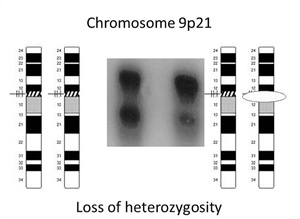December 1, 2012
UBC Dentistry professors Drs. Lewei Zhang, Catherine Poh, Michele Williams and Denise Laronde have taken a giant step closer to understanding the complex stages involved in malignant transformation, giving clinicians and their patients better information for treatment options.
In a study* recently published in Cancer Prevention Research, Zhang and colleagues identified a group of molecular markers that can help clinicians determine which patients with low-grade oral precancers are at high risk for cancer development.

Normally an individual has two alleles—one from the mother and one from the father. Because these have different origins of inheritance, the genotype is called heterozygous (left). The new test for oral cancer risk detects change in the gene of interest within an allele. If a mutation occurs and one of the alleles is lost, this is loss of heterozygosity (right).
Normally an individual has two alleles—one from the mother and one from the father. Because these have different origins of inheritance, the genotype is called heterozygous (left). The new test for oral cancer risk detects change in the gene of interest within an allele. If a mutation occurs and one of the alleles is lost, this is loss of heterozygosity (right).
This study, which spanned 10 years and built on a previous risk model that showed loss of heterozygosity may predict the progression of cancer, involved analyzing lesion samples submitted to the BC Oral Biopsy Service by dentists and surgeons from across the province. “By analyzing patients with mild or moderate oral dysplasia through the years, and including two additional markers to better differentiate patients’ risk, we were able to categorize patients into low-, intermediate- and high-risk groups,” says Zhang, who is one of two oral pathologists running the provincial oral biopsy service.
Using the loss of heterozygosity model to reliably differentiate progression risk for oral precancers has tremendous implications for treatment management. Poh explains: “Patients with oral lesions can be grouped according to risk level. We can increase surveillance for patients with elevated risk, improve target intervention for high-risk patients, and spare a large number of low-risk patients needless screening and treatment.” In terms of possible guidelines, Williams suggests that follow-up and treatment could be tailored to a patient’s risk level.
*Zhang L, Poh C, Williams M, Laronde D, Berean K, Gardner P, Jiang H, Wu L, Lee J, Rosin M. (2012). Loss of heterozygosity (LOH) profiles—Validated risk predictors for progression to oral cancer. Cancer Prevention Research, 5(9): 1081-1089.